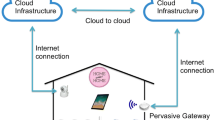Abstract
The EasyLiving project is concerned with development of an architecture and technologies for intelligent environments which allow the dy- namic aggregation of diverse I/O devices into a single coherent user experi- ence. Components of such a system include middleware (to facilitate distrib- uted computing), world modelling (to provide location-based context), perception (to collect information about world state), and service description (to support decomposition of device control, internal logic, and user interface). This paper describes the current research in each of these areas, highlighting some common requirements for any intelligent environment.
Access this chapter
Tax calculation will be finalised at checkout
Purchases are for personal use only
Preview
Unable to display preview. Download preview PDF.
Similar content being viewed by others
References
M. D. Addlesee, et al,‘ORL Active Floor’, IEEE Personal Communications, Vol.4, No.5, October 1997, pp. 35–41.
P. Bahl and V. N. Padmanabhan,‘RADAR: An In-Building RF based User Location and Tracking System’, Proceedings of IEEE INFOCOM 2000, Israel, March 2000.
Michael Coen,‘Design Principals for Intelligent Environments’, Intelligent Environments, Papers from the AAAI Spring Symposium, March 23–25, 1998, Technical Report SS-98-02, AAAI Press.
M. Coen, et al,‘Meeting the Computation Needs of Intelligent Environments: The Metaglue Environment’, Managing Interactions in Smart Environments, Springer-Verlag, 1999, pp. 201–213.
CORBA,‘Remote Invocation’, http://sisyphus.omg.org/gettingstarted/corbafaq. htm#RemoteInvoke.
P. Couderc, A.-M. Kermarrec,‘Enabling Context-Awareness from Network-Level Location Tracking’, Handheld and Ubiquitous Computing, First International Symposium, Springer-Verlag, 1999, pp. 67–73.
A. Dey, et al,‘A Context-based Infrastructure for Smart Environments’, Managing Interactions in Smart Environments, Springer-Verlag, 1999, pp. 114–130.
G, Eddon, et al, Inside Distributed COM, Microsoft Press, 1998.
A. Harter, et al,‘The Anatomy of a Context-Aware Application’, Proceedings of the MOBICOMí99, August 1999.
J. Krumm, et al‘Multi-Camera Multi-Person Tracking for EasyLiving’, Third IEEE International Workshop on Visual Surveillance, July 1, 2000, Dublin, Ireland.
R. Josè and N. Davies,‘Scalable and Flexible Location-Based Services for Ubiquitous Information Access’, Handheld and Ubiquitous Computing, First International Symposium, Springer-Verlag, 1999, pp. 52–66.
N. Marmasse, C. Schmandt,‘comMotion: a context-aware communication system’, http:// www.media.mit.edu/~nmarmas/comMotion.html.
M. Mozer,‘The Neural Network House: An Environment that Adapts to its Inhabitants’, Intelligent Environments, Papers from the AAAI Spring Symposium, March 23-25, 1998, Technical Report SS-98-02, AAAI Press.
N. Minar, et al,‘Hive: Distributed Agents for Networking Things’, Joint Proceedings of ASA/MA, 1999.
R. Smith, P. Cheeseman,‘On the Representation and Estimation of Spatial Uncertainty’, International Journal of Robotics Research, Vol. 5, No. 4, Winter 1986, pp. 56–67.
S. Shafer, et al,‘The New EasyLiving Project at Microsoft Research’, Proceedings of the 1998 DARPA / NIST Smart Spaces Workshop, July 1998, pp.127–130.
Triclops Stereo Cameras, Pt. Grey Research, http://www.ptgrey.com/.
Universal Plug and Play, http://www.upnp.org/resources.htm.
R. Want., A. Hopper,‘Active Badges and Personal Interactive Computing Objects’, IEEE Transactions on Consumer Electronics. Vol 38. No.1, Feb. 1992, pp.10–20.
A. Ward, et al,‘A New Location Technique for the Active Office’, IEEE Personal Communications, Vol. 4, No. 5, Oct. 1997, pp. 42–47.
Author information
Authors and Affiliations
Editor information
Editors and Affiliations
Rights and permissions
Copyright information
© 2000 Springer-Verlag Berlin Heidelberg
About this paper
Cite this paper
Brumitt, B., Meyers, B., Krumm, J., Kern, A., Shafer, S. (2000). EasyLiving: Technologies for Intelligent Environments. In: Thomas, P., Gellersen, HW. (eds) Handheld and Ubiquitous Computing. HUC 2000. Lecture Notes in Computer Science, vol 1927. Springer, Berlin, Heidelberg. https://doi.org/10.1007/3-540-39959-3_2
Download citation
DOI: https://doi.org/10.1007/3-540-39959-3_2
Published:
Publisher Name: Springer, Berlin, Heidelberg
Print ISBN: 978-3-540-41093-5
Online ISBN: 978-3-540-39959-9
eBook Packages: Springer Book Archive




